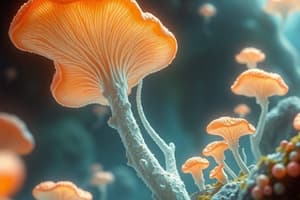Podcast
Questions and Answers
What type of ribosomes do fungi have in their cells?
What type of ribosomes do fungi have in their cells?
- 70S
- 80S (correct)
- 90S
- 50S
Which statement best describes the nutrient acquisition method of fungi?
Which statement best describes the nutrient acquisition method of fungi?
- They absorb nutrients. (correct)
- They use chemosynthesis.
- They intake nutrients through phagocytosis.
- They utilize photosynthesis.
What is the main structural component of the cell wall in most fungi?
What is the main structural component of the cell wall in most fungi?
- Lignin
- Cellulose
- Chitin (correct)
- Pectin
Which of the following is a form of fungi that is unicellular and reproduces by budding?
Which of the following is a form of fungi that is unicellular and reproduces by budding?
Which of the following temperature conditions is suitable for the growth of most fungi?
Which of the following temperature conditions is suitable for the growth of most fungi?
What type of fungi can have melanized cell walls containing pigments?
What type of fungi can have melanized cell walls containing pigments?
Which component in fungal membranes is targeted by many antifungal drugs like azoles?
Which component in fungal membranes is targeted by many antifungal drugs like azoles?
Fungi that obtain energy from breaking down dead matter are classified as what?
Fungi that obtain energy from breaking down dead matter are classified as what?
What type of nutritional strategy involves fungi requiring organic compounds for both carbon and energy sources?
What type of nutritional strategy involves fungi requiring organic compounds for both carbon and energy sources?
Which statement accurately describes most fungi regarding their relationship with other organisms?
Which statement accurately describes most fungi regarding their relationship with other organisms?
Flashcards are hidden until you start studying
Study Notes
Characteristics of Fungi
- Fungi are eukaryotic, meaning their cells contain membrane-bound organelles such as nuclei, mitochondria, and Golgi apparatus.
- They are heterotrophic, obtaining energy by breaking down dead or decaying matter, forming symbiotic relationships, or infecting other organisms.
- Fungi are chemoheterotrophs, requiring organic compounds for both carbon and energy sources, and lack chlorophyll.
- Their cell walls are rigid and made of chitin, except for lower fungi which have cell walls made of cellulose.
- Fungal membranes contain ergosterols, a site of action for many antifungal drugs such as azoles.
Cell Wall and Pigments
- Some fungi have melanized cell walls with brown or black pigments.
Motility and Structure
- Fungi are non-motile, except for lower fungi.
- They can be unicellular (yeasts) or multicellular (molds).
- Yeasts reproduce by budding, while molds consist of thread-like structures called hyphae that form a mat-like structure called mycelium.
Nutrition and Growth
- Fungi obtain their nutrients by absorption (osmotrophic).
- They grow best in slightly acidic conditions (pH 5-6.5).
- Fungi can grow in high salt and sugar conditions, and are osmophilic, meaning they thrive in high osmotic environments.
- Most fungi grow at temperatures around 28°C, except for pathogenic fungi which grow at 37°C.
Studying That Suits You
Use AI to generate personalized quizzes and flashcards to suit your learning preferences.




